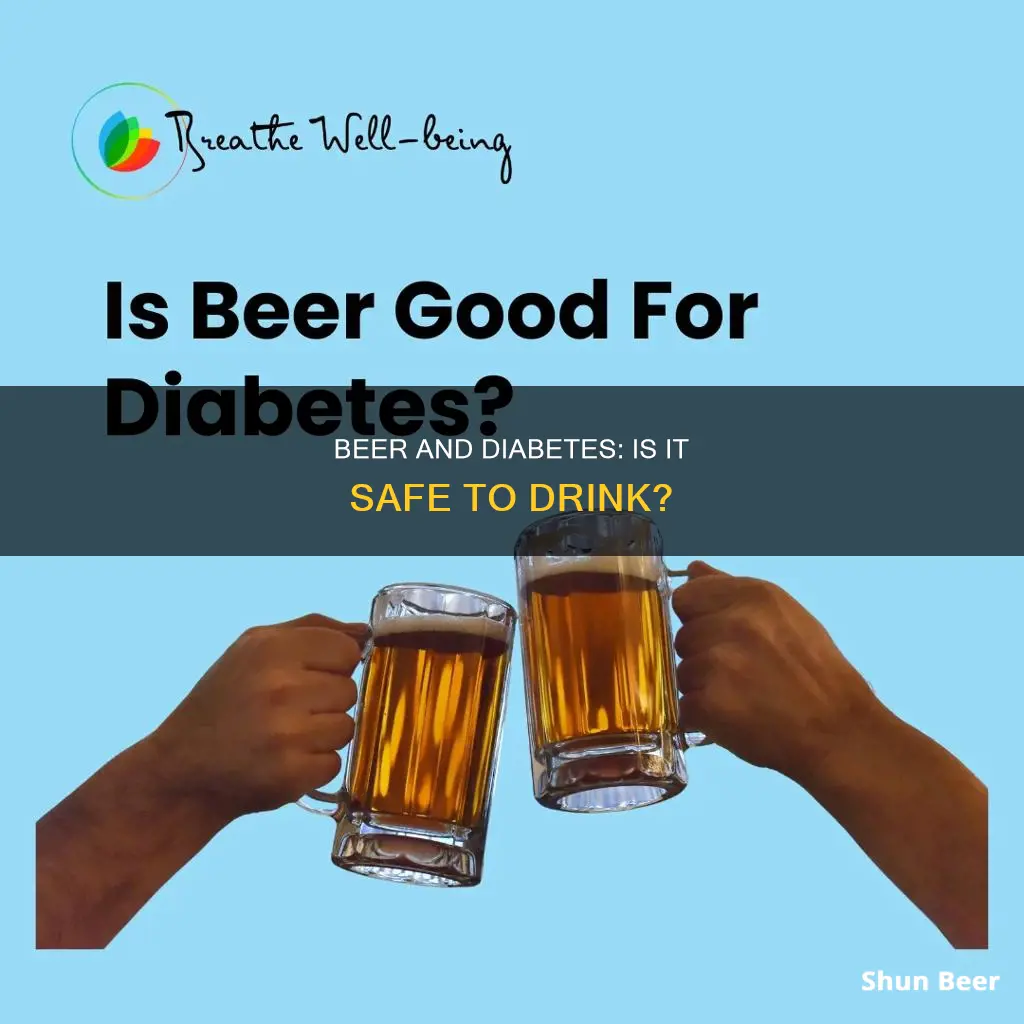
People with diabetes do not need to abstain from alcohol entirely, but they should be mindful of how it can affect their body and how to manage this. Beer is a significant source of carbohydrates, so it can impact blood sugar. Depending on the type, it can also be high in calories, so drinking beer may contribute to weight gain over time. Some types of beer can be higher in alcohol, too. Additionally, according to the ADA, drinking alcohol can slow down carb metabolism, potentially leading to low blood sugar (hypoglycemia).
| Characteristics | Values |
|---|---|
| Can diabetes patients drink beer? | Yes, but in moderation and with caution. |
| How much is too much? | No more than one drink a day for women and up to two drinks a day for men. |
| How does beer impact blood sugar levels? | Beer contains carbohydrates and alcohol, which can cause blood sugar to rise or fall. |
| What are the risks of drinking beer with diabetes? | Hypoglycemia (low blood sugar), weight gain, interference with diabetes medication, increased triglyceride levels, and high blood pressure. |
| How to drink beer safely with diabetes? | Drink in moderation, don't drink on an empty stomach, check blood sugar frequently, and consult a healthcare professional for advice. |
What You'll Learn

Beer and blood sugar levels
Beer can impact your blood sugar levels in several ways. Firstly, beer is a significant source of carbohydrates, which can cause a rapid increase in blood glucose levels. The amount of alcohol in beer can also interfere with the body's ability to regulate blood sugar, leading to both high and low blood sugar levels. Additionally, the calories in beer can contribute to weight gain over time, further affecting blood sugar control.
The Effect of Beer on Blood Sugar
Beer contains carbohydrates that are quickly absorbed into the bloodstream, leading to elevated blood sugar levels. This effect is more pronounced in people with diabetes, as their bodies have difficulty regulating blood sugar. The alcohol in beer can also interfere with the hormones that regulate blood sugar, such as insulin, and can reduce the effectiveness of insulin over time. This can result in high blood sugar levels, known as hyperglycemia, which can damage organs and body tissues.
The Risk of Hypoglycemia
Drinking beer, especially in excess, can also lead to low blood sugar levels, or hypoglycemia. This is because the liver, which is responsible for releasing stored glucose into the bloodstream, is also tasked with clearing alcohol from the body. The competition between these two processes can delay the release of glucose, causing a drop in blood sugar levels. Hypoglycemia can be dangerous and lead to symptoms such as dizziness, confusion, and even loss of consciousness. People with diabetes need to be particularly cautious as the symptoms of low blood sugar can be similar to those of being drunk, and alcohol can cloud their judgment, making it difficult to recognize the signs.
Tips for Drinking Beer with Diabetes
If you have diabetes and want to drink beer, it is important to do so safely. Here are some tips to help manage your blood sugar levels:
- Drink in moderation: Limit your intake to one to two beers per day, as recommended by the Dietary Guidelines for Americans.
- Don't drink on an empty stomach: Always have food with your beer to prevent hypoglycemia.
- Monitor your blood sugar: Check your blood sugar levels before and after drinking, and up to 24 hours after, to ensure they remain stable.
- Stay hydrated: Drink water along with your beer to maintain hydration.
- Be mindful of medication interactions: If you are taking diabetes medications, consult your healthcare team about possible effects when mixing alcohol and medication.
- Choose lower-carb options: Opt for light beers or other lower-carb alcoholic beverages to reduce the impact on your blood sugar levels.
- Be aware of the symptoms: Know the signs of hypoglycemia and be prepared to treat it if it occurs.
- Carry identification: Wear medical ID jewelry or carry a keychain/phone case that indicates you have diabetes, in case of emergencies.
Beer and Drug Testing: What's the Verdict?
You may want to see also

Alcohol and diabetes medications
People with diabetes can drink alcohol, but they need to be cautious and aware of how it can affect their body and how to manage this. Alcohol can interfere with blood sugar levels and increase the risk of developing type 2 diabetes. It is recommended that people with diabetes follow the same guidelines as the general population: no more than one drink per day for women and up to two drinks per day for men.
Alcohol and the liver
The liver is responsible for clearing alcohol from the body and stabilising glucose levels by storing and releasing carbohydrates into the bloodstream. When you drink alcohol, your liver has to work to remove it from your blood instead of regulating blood sugar. This can lead to hypoglycemia, or low blood sugar, which can be dangerous. The risk of hypoglycemia is higher if you drink on an empty stomach, so it is recommended to eat food before or while drinking alcohol.
Alcohol can interact with diabetes medications, including insulin and sulphonylureas, and increase the risk of hypoglycemia. It is important for people with diabetes to talk to their doctor about their drinking habits and how alcohol may impact their condition and medication.
Other precautions
It is important to test blood sugar levels before, during, and up to 24 hours after drinking alcohol. Alcohol can cause low blood sugar levels for up to 24 hours after drinking. It is also important to stay hydrated by drinking plenty of water while consuming alcohol.
Left-Out Beer: Drink or Ditch?
You may want to see also

Recommended serving sizes
It is important to note that drinking alcohol can affect your blood sugar levels, so you need to limit your intake to what is safe for you by knowing your own limits. The recommended serving sizes for beer are as follows:
According to the National Institute on Alcohol Abuse and Alcoholism, a serving of beer is 12 ounces and 5% alcohol. This is considered one drink. However, it is important to note that in bars and restaurants, the serving sizes may differ, with a pint glass holding 16 ounces. Therefore, when ordering a beer, it is advisable to opt for a can or bottle, which typically comes in a 12-ounce size. If you choose to drink on tap, you can request a smaller size or be mindful of the extra ounces in a pint.
It is recommended that females limit their daily alcohol intake to no more than one drink per day, which equates to one 12-ounce can or bottle of beer. For males, the recommendation is up to two drinks per day, or two 12-ounce servings of beer. It is important to abide by these guidelines to ensure safe and moderate consumption, especially for those living with diabetes.
When it comes to choosing the best type of beer, "light" beers are recommended as they typically contain the lowest amount of carbohydrates, calories, and alcohol. These beers usually have 5 or fewer grams of carbohydrates per serving. On the other hand, craft beers like IPAs and stouts tend to be much higher in carbs, often containing 15 grams or more per serving. They also tend to be higher in alcohol content, so it is advisable to stick to just one serving of these beers.
Additionally, drinking in moderation and pairing your beer with food can help prevent spikes and drops in blood sugar levels. It is also important to stay hydrated by drinking water along with your beer.
Dry January: Beer or No Beer?
You may want to see also

Eating while drinking
If you have diabetes, drinking alcohol can cause low or high blood sugar, affect diabetes medications, and cause other possible problems. However, this does not mean that you need to cut alcohol out of your diet completely. In fact, light drinking (no more than one to two drinks a day) may be beneficial to diabetes. Nevertheless, there are some important safety considerations to keep in mind.
Firstly, alcohol competes with your liver’s ability to make glucose when your blood sugar is low. If you are on insulin or other diabetes medications, this can lead to dangerously low blood sugar up to 24 hours after you stop drinking. Alcohol can also cloud your judgement, so you may not realise that your blood sugar is low. Therefore, it is important to prevent hypoglycaemia by not drinking on an empty stomach. Make sure you have food handy while you are drinking and keep checking your blood sugar.
If you are going to be drinking over several hours, such as at a sporting event, pace yourself and don’t overindulge. A good rule of thumb is to have no more than one drink per hour, and no more than three (for women) or four (for men) drinks in a day. Drink plenty of water to stay hydrated.
When it comes to choosing a drink, beer is typically higher in carbs than other alcoholic drinks like wine or liquor. “Light” beers have the least carbs, usually 5 or fewer grams per serving, and are also lower in alcohol content. So if you know you’re going to be drinking more than one beer, stick with light beers. Hoppy craft beers like IPAs and stouts tend to be much higher in carbs, usually 15 grams or more per serving, and are also higher in calories and alcohol, so it’s best to stick with just one serving.
If you are taking insulin or certain types of diabetes medicine, drinking alcohol can cause seriously low blood sugar. Drinking without eating food at the same time also greatly increases this risk. The risk for low blood sugar remains for hours after you take your last drink. The more drinks you have at one time, the higher your risk. This is why you should only drink alcohol with food and always in moderation.
Drinking and Driving: Is it Safe to Drive After Beers?
You may want to see also

Calories and weight gain
Beer is an alcoholic drink made from grain, such as barley, wheat, or rye, and flavoured with hops. The alcohol content of beer is usually 4–6% but can range from 0.5% to 40%. Beer is high in carbohydrates and calories, with a typical beer containing 150 calories, and some stouts and ales containing as many as 250 calories.
The high calorie content in beer can lead to weight gain, including around the middle, commonly referred to as a "beer belly". The more alcohol consumed, the higher the chance of developing a "beer belly". Beer is particularly associated with fat in the midsection because when you drink alcohol, the liver burns alcohol instead of fat.
Beer calories are easy to overdo, and drinking several beers in one sitting can result in a serious calorie overload. Alcohol also increases appetite, and the food typically consumed with beer, such as pizza, wings, and other fried foods, is often high in fat and calories.
Men are more likely to develop a "beer belly" than women due to differences in metabolism and the tendency to store fat around the belly. Additionally, men are more likely to drink beer, which contains more calories than many other alcoholic drinks.
To prevent weight gain, it is recommended to stick to light beers with 100 calories or less and to limit the number of beers consumed per day. It is also beneficial to drink alcohol only on weekends and to alternate alcoholic drinks with low-calorie, non-alcoholic beverages.
Breastfeeding and Non-Alcoholic Beer: What's Safe to Drink?
You may want to see also







